| Listing 1 - 10 of 12 | << page >> |
Sort by
|
Book
ISBN: 0669058726 Year: 1984 Publisher: Lexington (Mass.) : Lexington books,
Abstract | Keywords | Export | Availability | Bookmark
 Loading...
Loading...Choose an application
- Reference Manager
- EndNote
- RefWorks (Direct export to RefWorks)

ISBN: 0669097543 Year: 1986 Publisher: Lexington, MA : Lexington Books,
Abstract | Keywords | Export | Availability | Bookmark
 Loading...
Loading...Choose an application
- Reference Manager
- EndNote
- RefWorks (Direct export to RefWorks)
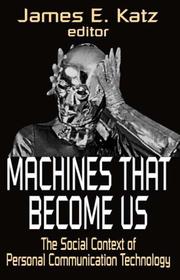
ISBN: 9781412806213 0765801582 Year: 2003 Publisher: New Brunswick (N.J.) Transaction
Abstract | Keywords | Export | Availability | Bookmark
 Loading...
Loading...Choose an application
- Reference Manager
- EndNote
- RefWorks (Direct export to RefWorks)
#SBIB:309H103 --- #SBIB:309H1711 --- Mediatechnologie / ICT / digitale media: sociale en culturele aspecten --- Nieuwe media, informatietechnologie (videotex, beeldplaat, interactieve televisie, vergadertelevisie,...) --- Information society --- Telecommunication --- Information technology --- Société informatisée --- Télécommunications --- Technologie de l'information --- Congresses. --- Social aspects --- Congresses --- Congrès --- Aspect social
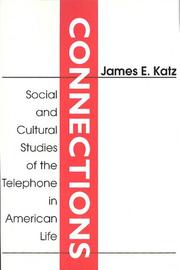
ISBN: 1351289985 1351289993 9781351289986 9780765809957 9781560003946 1560003944 Year: 2017 Publisher: London, [England] ; New York, New York : Routledge,
Abstract | Keywords | Export | Availability | Bookmark
 Loading...
Loading...Choose an application
- Reference Manager
- EndNote
- RefWorks (Direct export to RefWorks)
Telephone --- Social aspects --- United States --- History.
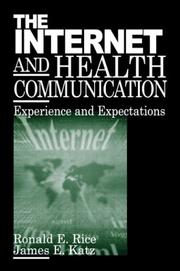
ISBN: 0761922334 1322416125 0761922326 1452233276 1452264422 9781452264424 9781452233277 9780761922322 9780761922339 Year: 2001 Publisher: Thousand Oaks, Calif : Sage Publications,
Abstract | Keywords | Export | Availability | Bookmark
 Loading...
Loading...Choose an application
- Reference Manager
- EndNote
- RefWorks (Direct export to RefWorks)
This book provides an in-depth analysis of the changes in human communication and health care resulting from the Internet revolution.
Sociology of health --- Computer architecture. Operating systems --- Mass communications --- Health --- -Internet. --- Medical telematics --- Communication in medicine --- #SBIB:309H261 --- #SBIB:309H103 --- #SBIB:309H1713 --- #SBIB:034.AANKOOP --- Health communication --- Medical communication --- Medicine --- Clinical telematics --- Health telematics --- Telehealth --- Medical informatics --- Telecommunication in medicine --- Telematics --- DARPA Internet --- Internet (Computer network) --- Wide area networks (Computer networks) --- World Wide Web --- Personal health --- Wellness --- Physiology --- Diseases --- Holistic medicine --- Hygiene --- Well-being --- Computer network resources --- Voorlichting: toepassingsgebieden --- Mediatechnologie / ICT / digitale media: sociale en culturele aspecten --- Mediatechnologie: nieuwe toepassingen (abonnee-televisie, electronic mail, desk top publishing, virtuele realiteit...) --- -Internet --- Internet. --- Medical telematics. --- Communication in medicine. --- Computer network resources.

ISBN: 0521002664 0521807719 0511176163 051104190X 0511156898 0511329431 0511489471 1280430451 0511044526 9780521002660 9780521807715 9780511489471 110712462X 9780511329432 9780511041907 9780511044526 9780511156892 9781280430459 9786610430451 6610430454 9780511176166 Year: 2002 Publisher: Cambridge, UK ; New York : Cambridge University Press,
Abstract | Keywords | Export | Availability | Bookmark
 Loading...
Loading...Choose an application
- Reference Manager
- EndNote
- RefWorks (Direct export to RefWorks)
The spread of mobile communication, most obtrusively as cell phones but increasingly in other wireless devices, is affecting people's lives and relationships to a previously unthought-of extent. Mobile phones, which are fast becoming ubiquitous, affect either directly or indirectly every aspect of our personal and professional lives. They have transformed social practices and changed the way we do business, yet surprisingly little serious academic work has been done on them. This 2002 book, with contributions from the foremost researchers in the field, studies the impact of the mobile phone on contemporary society from a social scientific perspective. Providing a comprehensive overview of mobile phones and social interaction, it comprises an introduction covering the key issues, a series of unique national studies and a final section examining specific issues.
Cell phones --- Wireless communication systems --- Social aspects. --- Cellular telephones. --- Wireless communication systems - Social aspects. --- Communication systems, Wireless --- Wireless data communication systems --- Wireless information networks --- Wireless telecommunication systems --- Telecommunication systems --- Social aspects --- Social Sciences --- Sociology --- #SBIB:309H103 --- #SBIB:309H1711 --- Mediatechnologie / ICT / digitale media: sociale en culturele aspecten --- Nieuwe media, informatietechnologie (videotex, beeldplaat, interactieve televisie, vergadertelevisie,...) --- Cell phones - Social aspects --- Wireless communication systems - Social aspects
Book
ISBN: 0190900296 019090027X 0190900288 Year: 2019 Publisher: New York, NY : Oxford University Press,
Abstract | Keywords | Export | Availability | Bookmark
 Loading...
Loading...Choose an application
- Reference Manager
- EndNote
- RefWorks (Direct export to RefWorks)
This volume gathers leading scholars in the fields of journalism and communication studies, philosophy, and the social sciences to examine critical questions of how we should understand journalism's changing landscape as it relates to fundamental questions about the role of truth and information in society.
Journalism. --- Truth in literature. --- Fake news. --- Social media. --- User-generated media --- Communication --- User-generated content --- News, Fake --- Disinformation --- Hoaxes --- Journalism --- Writing (Authorship) --- Literature --- Publicity --- Fake news
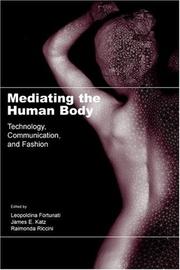
ISBN: 0805844805 0805844813 9780805844818 9780805844801 Year: 2003 Publisher: Mahwah, N.J. : Lawrence Erlbaum Associates, Publishers,
Abstract | Keywords | Export | Availability | Bookmark
 Loading...
Loading...Choose an application
- Reference Manager
- EndNote
- RefWorks (Direct export to RefWorks)
Human body --- Human figure in art. --- Human-computer interaction. --- Communication and technology. --- Mass media and technology. --- Technology and civilization. --- Corps humain --- Corps humain dans l'art --- Interaction homme-machine (Informatique) --- Communication et technologie --- Médias et technologie --- Technologie et civilisation --- Social aspects --- Aspect social --- Body, Human --- Human beings --- Human figure in art --- Human-computer interaction --- Technology and civilization --- Advertising
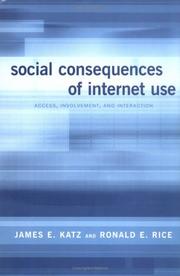
ISBN: 9780262256506 0262256509 0585434980 9780585434988 9780262112697 0262112698 1282096516 9781282096516 9786612096518 6612096519 Year: 2002 Publisher: Cambridge, Mass. : MIT Press,
Abstract | Keywords | Export | Availability | Bookmark
 Loading...
Loading...Choose an application
- Reference Manager
- EndNote
- RefWorks (Direct export to RefWorks)
Drawing on nationally representative telephone surveys conducted from 1995 to 2000, James Katz and Ronald Rice offer a rich and nuanced picture of Internet use in America. Using quantitative data, as well as case studies of Web sites, they explore the impact of the Internet on society from three perspectives: access to Internet technology (the digital divide), involvement with groups and communities through the Internet (social capital), and use of the Internet for social interaction and expression (identity). To provide a more comprehensive account of Internet use, the authors draw comparisons across media and include Internet nonusers and former users in their research. The authors call their research the Syntopia Project to convey the Internet's role as one among a host of communication technologies as well as the synergy between people's online activities and their real-world lives. Their major finding is that Americans use the Internet as an extension and enhancement of their daily routines. Contrary to media sensationalism, the Internet is neither a utopia, liberating people to form a global egalitarian community, nor a dystopia-producing armies of disembodied, lonely individuals. Like any form of communication, it is as helpful or harmful as those who use it.
Internet --- Digital divide --- Telecommunication --- Electric communication --- Mass communication --- Telecom --- Telecommunication industry --- Telecommunications --- Communication --- Information theory --- Telecommuting --- DARPA Internet --- Internet (Computer network) --- Wide area networks (Computer networks) --- World Wide Web --- Social aspects --- INFORMATION SCIENCE/Technology & Policy
Book
ISBN: 0190900261 9780190900250 0190900261 0190900253 9780190900267 9780190900267 Year: 2019 Publisher: New York (N.Y.): Oxford university press,
Abstract | Keywords | Export | Availability | Bookmark
 Loading...
Loading...Choose an application
- Reference Manager
- EndNote
- RefWorks (Direct export to RefWorks)
Truth qualities of journalism are under intense scrutiny in today's world. Journalistic scandals have eroded public confidence in mainstream media while pioneering news media compete to satisfy the public's appetite for news. Still worse is the specter of "fake news" that looms over media and political systems that underpin everything from social stability to global governance.This volume aims to illuminate the contentious media landscape to help journalism students, scholars, and professionals understand contemporary conditions and arm them to deal with a spectrum of new developments ranging from technology and politics to best practices.
Online journalism --- Fake news --- Journalism --- Press and propaganda --- Social media
| Listing 1 - 10 of 12 | << page >> |
Sort by
|

 Search
Search Feedback
Feedback About UniCat
About UniCat  Help
Help News
News